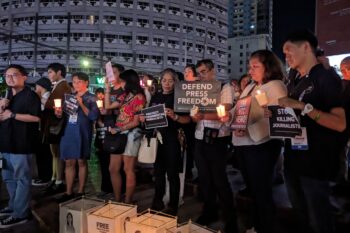First of two parts
CAGAYAN DE ORO CITY (MindaNews/08 January) — I do not want to understand the tragic event of typhoon “Sendong” and other ecological disasters either as the will of God or as simply part of the fate of the Filipinos whose lives have always been punctuated by a struggle to survive the devastating plagues of nature. I firmly believe that the evils of ecological disaster could not purely be attributed to the natural consequences of our evolutionary world. They also have human causes which can be mitigated. Many of them are anthropogenic and human-induced factors which can be overcome.
Our present situation is challenging us to be always alert and discerning as to the pulse of what is going on in history. A crucial part of our discernment is to listen not only to the cry of the poor but also to the groaning of creation. The latter is quite challenging as it calls us to allow beings on our planet—air, water, energy, earth, living beings—to speak with us. As a conversation partner, nature has to be treated as a subject with a voice. Those who have intimate relationship with nature—such as the indigenous environmentalists and ecological scientists—are able to listen to the voices of nature and discern the message of God in them. Today, they remind us of our ecological sins and warn us of our imminent fate—like Noah and the ancient prophets.
In what follows, let me point out both the natural causes and anthropogenic factors of our ecological crisis. This leads me to portray the Philippine as a country deprived of the ecosystem services of the forests.
An archipelago in the “Chain of Fire”
As seen from above, the Philippine archipelago may be seen as “half-drowned mountains” which appear to be part of a long and wide cordillera extending from Indonesia to Japan. Thus, from this view, the Philippines may be seen as a chain of at least 7,107 islands (including the islets, huge rocks and sand bars at the mouths of rivers) that stretch 1,840 kilometers from north to south, separated by inland seas and surrounded by ocean waters. As we know, the Philippine archipelago has a total land area of 29,817,000 hectares. It is gifted with a total coastline of 36,289 kilometers—a size which, as IBON Philippines has reported, is almost twice that of the United States.’
Topographically, the World Bank affirmed in 1989 that about 56% of the Philippines’ total land area is hilly or mountainous uplands, of which 46 per cent are composed of 18-30% slopes (or equivalent to a 10 degrees angle elevation). Considering its narrow and mountainous terrain, Percy Sajise and colleagues ( in the book Saving the Present for the Future, 1992) have argued that the Philippines should ideally maintain a forest cover of 54% of its total land area in order to maintain a stable ecosystem and to ensure a habitable environment. Moreover, being situated within the Pacific “ring of fire,” the Philippine archipelago has to maintain a sufficient forest cover, as it is affected by yearly occurrence of large-scale natural disasters throughout its geological history. In fact, an average of 20 tropical cyclones hit the Philippines every year, and about nine of them cross the land.
A country with colonized forests
The Filipinos are victims of ecological poverty. Unfortunately, many of our Philippine historians fail to take account of the fact that the various forms of social oppression in the colonial period have always been accompanied by ecological exploitation of the natural resources. Nevertheless, it is clear to us that our colonizers did not only impoverish our human resources, but also grossly exploited our natural resources.
The history of Philippines attests to the fact of massive deforestation. It has been said that when the group of Magellan first saw the Philippine islands in 1521, the archipelago had an estimated forest cover of 90% of its total land area. After 333 years of Spanish colonization, it was reported that the country’s forest area comprised about 70% of its total land area. In other words, the Spanish colonizers had harvested about 20% of the country’s original forest cover. Moreover, after 48 years (from 1898 to 1946) of US colonization, the Philippines had an estimated remaining forest cover of 50% of its total land area. This means that, at a relatively short period of time, the US colonizers were able to harvest 20% of the country’s original forest cover. As the Environmental Science for Social Change (ESSC) has pointed out, the threshold in sustainable forest management was already crossed between 1945 and 1950. In short, the US colonizers did not release the Philippines from their hands until the country’s forest cover became ecologically unsustainable.
The Philippine government continued the deforestation process by uncritically adopting the unsustainable ecological policies and programs of our foreign colonizers. Marites Vitug reported in 1993 that the decade of the 1960s has been considered the peak of massive deforestation in the Philippines. Moreover, in his study in 1990, Germelino Bautista revealed that about 85% of the remaining Philippine forest lands were still under a license agreement until 1987. Alarmingly, as of 2002, the Forest Management Bureau (FMB) estimated that the Philippine islands have a remaining forest cover of about 24% of its total land area. As we have pointed out, this percentage is already quite far from the required forest cover.
[Tomorrow: A nation with a devastated focal ecosystem]







